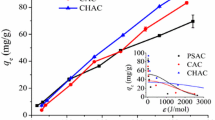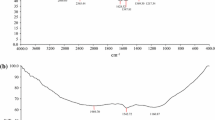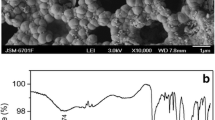Abstract
Activated carbon (AC) was prepared from surplus sludge using chemical activation method with the assistance of ZnCl2. The influences of process parameters on the AC’s specific surface area and adsorption capacity for Pb2+ were examined to optimize these parameters. The optimal conditions for the preparation of AC were determined to be activation temperature of 500 °C, activation time of 1 h, impregnation ratio of 1:1 (solid-to-liquid volume) with the 30% ZnCl2 solution (mass fraction), giving the BET surface area of 393.85 m2/g and yield of 30.14% with 33.45% ash. Also, the pyrolysis temperature was found to be the most important parameter in chemical activation. FTIR spectra provided the evidence of some surface structures such as C=C and C-O-C. In the adsorption studies, a rise in solution pH led to a significant increase in adsorption capacity when the pH value varied from 3.0 to 7.0, and the optimal pH for removal of Pb2+ was 7.0. It was observed that the pseudo-second-order equation provided better correlation for the adsorption rate than the pseudo-first-order and the Langmuir model fitted better than the Freundlich model for adsorption isotherm. The adsorption capacity of AC to Pb2+ was 11.75 mg/L at solution pH 7.0, the equilibrium time 480 min and 25 °C. Moreover, the adsorption process is endothermic according to the value of enthalpy change.
Similar content being viewed by others
References
SHUKLA S R, PAI R S. Adsorption of Cu(II), Ni(II) and Zn(II) on dye loaded groundnut shells and sawdust [J]. Separation and Purification Technology, 2005, 43(1): 1–8.
BULUT Y, BAYSAL Z. Removal of Pb(II) from wastewater using wheat bran [J]. Journal of Environmental Management, 2006, 78(2): 107–113.
AROUA M K, LEONG S P P, TEO L Y, YIN C Y, DAUD WMAW. Real-time determination of kinetics of adsorption of lead(II) onto palm shell-based activated carbon using ion selective electrode [J]. Bioresource Technology, 2008, 99(13): 5786–5792.
BHATTACHARJEE S, CHAKRABARTY S, MAITY S, KAR S, THAKUR P, BHATTACHARYYA G. Removal of lead from contaminated water bodies using sea nodule as an adsorbent [J]. Water Research, 2003, 37(16): 3954–3966.
NALAPARAJU A, HU Z Q, ZHAO X S, JIANG J W. Exchange of heavy metal ions in titanosilicate Na-ETS-10 membrane from molecular dynamics simulations [J]. Journal of Membrane Science, 2009, 335(1/2): 89–95.
MAWEJA K, MUKONGO T, MUTOMBO I. Cleaning of a copper matte smelting slag from a water-jacket furnace by direct reduction of heavy metals [J]. Journal of Hazardous Materials, 2009, 164(2/3): 856–862.
CHEN Q Y, LUO Z, HILLS C, XUE G, TYRER M. Precipitation of heavy metals from wastewater using simulated flue gas: Sequent additions of fly ash, lime and carbon dioxide [J]. Water Research, 2009, 43(10): 2605–2614.
ABO-FARHA S A, ABDEL-AAL A Y, ASHOUR I A, GARAMON S E. Removal of some heavy metal cations by synthetic resin purolite C100 [J]. Journal of Hazardous Materials, 2009, 169(1/2/3): 190–194.
KARNITZ O, GURGEL L V A, de MELO J C P, BOTARO V R, MELO T M S, GIL R, GIL L F. Adsorption of heavy metal ion from aqueous single metal solution by chemically modified sugarcane bagasse [J]. Bioresource Technology, 2007, 98(6): 1291–1297.
ZAINI M A A, AMANO Y, MACHIDA M. Adsorption of heavy metals onto activated carbons derived from polyacrylonitrile fiber [J]. Journal of Hazardous Materials, 2010, 180(1/2/3): 552–560.
KADIRVELU K, KAVIPRIYA M, KARTHIKA C, RADHIKA M, VENNILAMANI N, PATTABHI S. Utilization of various agricultural wastes for activated carbon preparation and application for the removal of dyes and metal ions from aqueous solutions [J]. Bioresource Technology, 2003, 87(1): 129–132.
KOBYA M, DEMIRBAS E, SENTURK E, INCE M. Adsorption of heavy metal ions from aqueous solutions by activated carbon prepared from apricot stone [J]. Bioresource Technology, 2005, 96(13): 1518–1521.
DEMIRAL H, GUNDUZOGLU G. Removal of nitrate from aqueous solutions by activated carbon prepared from sugar beet bagasse [J]. Bioresource Technology, 2010, 101(6): 1675–1680.
QIAN Q R, CHEN Q H, MACHIDA M, TATSUMOTO H, MOCHIDZUKI K, SAKODA A. Removal of organic contaminants from aqueous solution by cattle manure compost (CMC) derived activated carbons [J]. Applied Surface Science, 2009, 255(12): 6107–6114.
HAMAD B K, NOOR A M, AFIDA A R, ASRI M N M. High removal of 4-chloroguaiacol by high surface area of oil palm shell-activated carbon activated with NaOH from aqueous solution [J]. Desalination, 2010, 257(1/2/3): 1–7.
BISHNOI N R, BAJAJ M, SHARMA N, GUPTA A. Adsorption of Cr(VI) on activated rice husk carbon and activated alumina [J]. Bioresource Technology, 2004, 91(3): 305–307.
WILSON K, YANG H, SEO C W, MARSHALL W E. Select metal adsorption by activated carbon made from peanut shells [J]. Bioresource Technology, 2006, 97(18): 2266–2270.
KRISHNAN K A, SREEJALEKSHMI K G, VARGHESE S. Adsorptive retention of citric acid onto activated carbon prepared from Havea braziliansis sawdust: Kinetic and isotherm overview [J]. Desalination, 2010, 257(1/2/3): 46–52.
GURSES A, DOGAR C, KARACA S, ACIKYILDIZ M, BAYRAK R. Production of granular activated carbon from waste Rosa canina sp seeds and its adsorption characteristics for dye [J]. Journal of Hazardous Materials, 2006, 131(1/2/3): 254–259.
MUN T Y, KANG B S, KIM J S. Production of a producer gas with high heating values and less tar from dried sewage sludge through air gasification using a two-stage gasifier and activated carbon [J]. Energy & Fuels, 2009, 23: 3268–3276.
SAHU J N, ACHARYA J, MEIKAP B C. Response surface modeling and optimization of chromium(VI) removal from aqueous solution using Tamarind wood activated carbon in batch process [J]. Journal of Hazardous Materials, 2009, 172(2/3): 818–825.
WANG X N, ZHU N W, YIN B K. Preparation of sludge-based activated carbon and its application in dye wastewater treatment [J]. Journal of Hazardous Materials, 2008, 153(1/2): 22–27.
TAY J H, SHOW K Y. Resource recovery of sludge as a building and construction material-A future trend in sludge management [J]. Water Science and Technology, 1997, 36(11): 259–266.
CATURLA F, MOLINA-SABIO M, RODRIGUEZ-REINOSO F. Preparation of activated carbon by chemical activation with ZnCl2 [J]. Carbon, 1991, 29(7): 999–1007.
RIO S, FAUR-BRASQUET C, LE COQ L, LE CLOIREC P. Structure characterization and adsorption properties of pyrolyzed sewage sludge [J]. Environmental Science & Technology, 2005, 39(11): 4249–4257.
AHMADPOUR A, DO D D. The preparation of activated carbon from macadamia nutshell by chemical activation [J]. Carbon, 1997, 35(12): 1723–1732.
ZHANG J B, ZHONG Z P, SHEN D K, ZHAO J X, ZHANG H Y, YANG M, LI W L. Preparation of bamboo-based activated carbon and its application in direct carbon fuel cells [J]. Energy & Fuels, 2011, 25(5): 2187–2193.
TAY J H, CHEN X G, JEYASEELAN S, GRAHAM N. Optimising the preparation of activated carbon from digested sewage sludge and coconut husk [J]. Chemosphere, 2001, 44(1): 45–51.
MORENO-CASTILLA C, CARRASCO-MARÍN F, MALDONADO-HÓDAR F J, RIVERA-UTRILLA J. Effects of non-oxidant and oxidant acid treatments on the surface properties of an activated carbon with very low ash content [J]. Carbon, 1998, 36(1/2): 145–151.
SHIN S, JANG J, YOON S H, MOCHIDA I. A study on the effect of heat treatment on functional groups of pitch based activated carbon fiber using FTIR [J]. Carbon, 1997, 35(12): 1739–1743.
FOO K Y, HAMEED B H. Microwave-assisted preparation of oil palm fiber activated carbon for methylene blue adsorption [J]. Chemical Engineering Journal, 2011, 166(2): 792–795.
ISSABAYEVA G, AROUA M K, SULAIMAN N M N. Removal of lead from aqueous solutions on palm shell activated carbon [J]. Bioresource Technology, 2006, 97(18): 2350–2355.
WANG X J, XIA S Q, CHEN L, ZHAO J F, CHOVELON J M, NICOLE J R. Biosorption of cadmium(II) and lead(II) ions from aqueous solutions onto dried activated sludge [J]. Journal of Environmental Sciences-China, 2006, 18(5): 840–844.
SEKAR M, SAKTHI V, RENGARAJ S. Kinetics and equilibrium adsorption study of lead(II) onto activated carbon prepared from coconut shell [J]. Journal of Colloid and Interface Science, 2004, 279(2): 307–313.
Author information
Authors and Affiliations
Corresponding author
Additional information
Foundation item: Project supported by the Open Fund of State Key Laboratory of Photocatalysis, China
Rights and permissions
About this article
Cite this article
Jiang, Zw., Wang, Xj. & Ning, X. Removal of lead(II) from aqueous solutions by activated carbon developed from surplus sludge. J. Cent. South Univ. 21, 3568–3574 (2014). https://doi.org/10.1007/s11771-014-2337-1
Received:
Accepted:
Published:
Issue Date:
DOI: https://doi.org/10.1007/s11771-014-2337-1




